| Listing 1 - 10 of 42 | << page >> |
Sort by
|
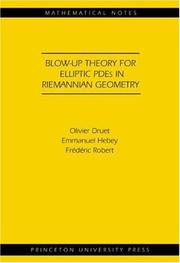
ISBN: 1282087231 1282935372 9786612935374 9786612087233 1400826160 9781400826162 0691119538 9780691119533 9781282087231 9781282935372 6612935375 6612087234 Year: 2004 Publisher: Princeton, N.J. Princeton University Press
Abstract | Keywords | Export | Availability | Bookmark
 Loading...
Loading...Choose an application
- Reference Manager
- EndNote
- RefWorks (Direct export to RefWorks)
Elliptic equations of critical Sobolev growth have been the target of investigation for decades because they have proved to be of great importance in analysis, geometry, and physics. The equations studied here are of the well-known Yamabe type. They involve Schrödinger operators on the left hand side and a critical nonlinearity on the right hand side. A significant development in the study of such equations occurred in the 1980's. It was discovered that the sequence splits into a solution of the limit equation--a finite sum of bubbles--and a rest that converges strongly to zero in the Sobolev space consisting of square integrable functions whose gradient is also square integrable. This splitting is known as the integral theory for blow-up. In this book, the authors develop the pointwise theory for blow-up. They introduce new ideas and methods that lead to sharp pointwise estimates. These estimates have important applications when dealing with sharp constant problems (a case where the energy is minimal) and compactness results (a case where the energy is arbitrarily large). The authors carefully and thoroughly describe pointwise behavior when the energy is arbitrary. Intended to be as self-contained as possible, this accessible book will interest graduate students and researchers in a range of mathematical fields.
Calculus of variations. --- Differential equations, Nonlinear. --- Geometry, Riemannian. --- Riemann geometry --- Riemannian geometry --- Generalized spaces --- Geometry, Non-Euclidean --- Semi-Riemannian geometry --- Nonlinear differential equations --- Nonlinear theories --- Isoperimetrical problems --- Variations, Calculus of --- Maxima and minima --- Asymptotic analysis. --- Cayley–Hamilton theorem. --- Contradiction. --- Curvature. --- Diffeomorphism. --- Differentiable manifold. --- Equation. --- Estimation. --- Euclidean space. --- Laplace's equation. --- Maximum principle. --- Nonlinear system. --- Polynomial. --- Princeton University Press. --- Result. --- Ricci curvature. --- Riemannian geometry. --- Riemannian manifold. --- Simply connected space. --- Sphere theorem (3-manifolds). --- Stone's theorem. --- Submanifold. --- Subsequence. --- Theorem. --- Three-dimensional space (mathematics). --- Topology. --- Unit sphere.
Book
ISBN: 0691223807 Year: 1988 Publisher: Princeton, New Jersey : Princeton University Press,
Abstract | Keywords | Export | Availability | Bookmark
 Loading...
Loading...Choose an application
- Reference Manager
- EndNote
- RefWorks (Direct export to RefWorks)
This book starts with the elementary theory of Lie groups of matrices and arrives at the definition, elementary properties, and first applications of cohomological induction, which is a recently discovered algebraic construction of group representations. Along the way it develops the computational techniques that are so important in handling Lie groups. The book is based on a one-semester course given at the State University of New York, Stony Brook in fall, 1986 to an audience having little or no background in Lie groups but interested in seeing connections among algebra, geometry, and Lie theory. These notes develop what is needed beyond a first graduate course in algebra in order to appreciate cohomological induction and to see its first consequences. Along the way one is able to study homological algebra with a significant application in mind; consequently one sees just what results in that subject are fundamental and what results are minor.
Lie groups. --- Algebra. --- Analytic group. --- Approximate identity. --- Associative algebra. --- Associativity formulas. --- Borel subalgebra. --- Borel-Weil Theorem. --- Boundary operator. --- Cartan subgroup. --- Chain map. --- Change of rings. --- Closed linear group. --- Cohomological induction. --- Complexification. --- Convolution. --- Derivation. --- Derived functor. --- Diffeomorphism. --- Divisible group. --- Dual vector space. --- Enough injectives. --- Equivalence. --- Euler-Poincare principle. --- Exponential. --- Forgetful functor. --- Free resolution. --- Functor. --- Good category. --- Haar measure. --- Highest weight. --- Homogeneous polynomial. --- Homogeneous tensor. --- I functor. --- Induction, cohomological. --- Inner derivation. --- Isotypic subspace. --- K-isotypic subspace. --- Left exact functor. --- Lie algebra. --- Lie bracket. --- Linear extension. --- Long exact sequence. --- Mackey isomorphism. --- Matrix coefficient. --- Multiplicity. --- Normalized Haar measure. --- Positive root. --- Quotient representation. --- Reductive group. --- Regular representation. --- Right exact functor. --- Schur orthogonality. --- Semidirect product. --- Spectral sequence.

ISBN: 0691002576 1400865182 9781400865185 9780691002583 9780691002576 0691002584 9780691002583 Year: 2014 Publisher: Princeton, NJ
Abstract | Keywords | Export | Availability | Bookmark
 Loading...
Loading...Choose an application
- Reference Manager
- EndNote
- RefWorks (Direct export to RefWorks)
In 1920, Pierre Fatou expressed the conjecture that--except for special cases--all critical points of a rational map of the Riemann sphere tend to periodic orbits under iteration. This conjecture remains the main open problem in the dynamics of iterated maps. For the logistic family x- ax(1-x), it can be interpreted to mean that for a dense set of parameters "a," an attracting periodic orbit exists. The same question appears naturally in science, where the logistic family is used to construct models in physics, ecology, and economics. In this book, Jacek Graczyk and Grzegorz Swiatek provide a rigorous proof of the Real Fatou Conjecture. In spite of the apparently elementary nature of the problem, its solution requires advanced tools of complex analysis. The authors have written a self-contained and complete version of the argument, accessible to someone with no knowledge of complex dynamics and only basic familiarity with interval maps. The book will thus be useful to specialists in real dynamics as well as to graduate students.
Geodesics (Mathematics) --- Polynomials. --- Mappings (Mathematics) --- Maps (Mathematics) --- Functions --- Functions, Continuous --- Topology --- Transformations (Mathematics) --- Algebra --- Geometry, Differential --- Global analysis (Mathematics) --- Mathematics --- Absolute value. --- Affine transformation. --- Algebraic function. --- Analytic continuation. --- Analytic function. --- Arithmetic. --- Automorphism. --- Big O notation. --- Bounded set (topological vector space). --- C0. --- Calculation. --- Canonical map. --- Change of variables. --- Chebyshev polynomials. --- Combinatorics. --- Commutative property. --- Complex number. --- Complex plane. --- Complex quadratic polynomial. --- Conformal map. --- Conjecture. --- Conjugacy class. --- Conjugate points. --- Connected component (graph theory). --- Connected space. --- Continuous function. --- Corollary. --- Covering space. --- Critical point (mathematics). --- Dense set. --- Derivative. --- Diffeomorphism. --- Dimension. --- Disjoint sets. --- Disjoint union. --- Disk (mathematics). --- Equicontinuity. --- Estimation. --- Existential quantification. --- Fibonacci. --- Functional equation. --- Fundamental domain. --- Generalization. --- Great-circle distance. --- Hausdorff distance. --- Holomorphic function. --- Homeomorphism. --- Homotopy. --- Hyperbolic function. --- Imaginary number. --- Implicit function theorem. --- Injective function. --- Integer. --- Intermediate value theorem. --- Interval (mathematics). --- Inverse function. --- Irreducible polynomial. --- Iteration. --- Jordan curve theorem. --- Julia set. --- Limit of a sequence. --- Linear map. --- Local diffeomorphism. --- Mathematical induction. --- Mathematical proof. --- Maxima and minima. --- Meromorphic function. --- Moduli (physics). --- Monomial. --- Monotonic function. --- Natural number. --- Neighbourhood (mathematics). --- Open set. --- Parameter. --- Periodic function. --- Periodic point. --- Phase space. --- Point at infinity. --- Polynomial. --- Projection (mathematics). --- Quadratic function. --- Quadratic. --- Quasiconformal mapping. --- Renormalization. --- Riemann sphere. --- Riemann surface. --- Schwarzian derivative. --- Scientific notation. --- Subsequence. --- Theorem. --- Theory. --- Topological conjugacy. --- Topological entropy. --- Topology. --- Union (set theory). --- Unit circle. --- Unit disk. --- Upper and lower bounds. --- Upper half-plane. --- Z0.
Book
ISBN: 0691197482 Year: 2021 Publisher: Princeton : Princeton University Press,
Abstract | Keywords | Export | Availability | Bookmark
 Loading...
Loading...Choose an application
- Reference Manager
- EndNote
- RefWorks (Direct export to RefWorks)
This volume gives a clear introductory account of equivariant cohomology, a central topic in algebraic topology. Assuming readers have taken one semester of manifold theory and a year of algebraic topology, Loring Tu begins with the topological construction of equivariant cohomology, then develops the theory for smooth manifolds with the aid of differential forms. To keep the exposition simple, the equivariant localisation theorem is proven only for a circle action. An appendix gives a proof of the equivariant de Rham theorem, demonstrating that equivariant cohomology can be computed using equivariant differential forms. Examples and calculations illustrate new concepts. Exercises include hints or solutions, making this book suitable for self-study.
Cohomology operations. --- Operations (Algebraic topology) --- Algebraic topology --- Algebraic structure. --- Algebraic topology (object). --- Algebraic topology. --- Algebraic variety. --- Basis (linear algebra). --- Boundary (topology). --- CW complex. --- Cellular approximation theorem. --- Characteristic class. --- Classifying space. --- Coefficient. --- Cohomology ring. --- Cohomology. --- Comparison theorem. --- Complex projective space. --- Continuous function. --- Contractible space. --- Cramer's rule. --- Curvature form. --- De Rham cohomology. --- Diagram (category theory). --- Diffeomorphism. --- Differentiable manifold. --- Differential form. --- Differential geometry. --- Dual basis. --- Equivariant K-theory. --- Equivariant cohomology. --- Equivariant map. --- Euler characteristic. --- Euler class. --- Exponential function. --- Exponential map (Lie theory). --- Exponentiation. --- Exterior algebra. --- Exterior derivative. --- Fiber bundle. --- Fixed point (mathematics). --- Frame bundle. --- Fundamental group. --- Fundamental vector field. --- Group action. --- Group homomorphism. --- Group theory. --- Haar measure. --- Homotopy group. --- Homotopy. --- Hopf fibration. --- Identity element. --- Inclusion map. --- Integral curve. --- Invariant subspace. --- K-theory. --- Lie algebra. --- Lie derivative. --- Lie group action. --- Lie group. --- Lie theory. --- Linear algebra. --- Linear function. --- Local diffeomorphism. --- Manifold. --- Mathematics. --- Matrix group. --- Mayer–Vietoris sequence. --- Module (mathematics). --- Morphism. --- Neighbourhood (mathematics). --- Orthogonal group. --- Oscillatory integral. --- Principal bundle. --- Principal ideal domain. --- Quotient group. --- Quotient space (topology). --- Raoul Bott. --- Representation theory. --- Ring (mathematics). --- Singular homology. --- Spectral sequence. --- Stationary phase approximation. --- Structure constants. --- Sub"ient. --- Subcategory. --- Subgroup. --- Submanifold. --- Submersion (mathematics). --- Symplectic manifold. --- Symplectic vector space. --- Tangent bundle. --- Tangent space. --- Theorem. --- Topological group. --- Topological space. --- Topology. --- Unit sphere. --- Unitary group. --- Universal bundle. --- Vector bundle. --- Vector space. --- Weyl group.
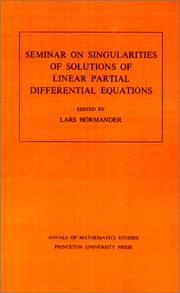
ISBN: 0691082219 0691082138 1400881587 0691082103 Year: 1979 Volume: 91 Publisher: Princeton, N.J.
Abstract | Keywords | Export | Availability | Bookmark
 Loading...
Loading...Choose an application
- Reference Manager
- EndNote
- RefWorks (Direct export to RefWorks)
Singularities of solutions of differential equations forms the common theme of these papers taken from a seminar held at the Institute for Advanced Study in Princeton in 1977-1978. While some of the lectures were devoted to the analysis of singularities, others focused on applications in spectral theory. As an introduction to the subject, this volume treats current research in the field in such a way that it can be studied with profit by the non-specialist.
Partial differential equations --- Differential equations, Linear --- Differential equations, Partial --- Equations différentielles linéaires --- Equations aux dérivées partielles --- Numerical solutions --- Congresses --- Solutions numériques --- Congrès --- Théorie asymptotique --- 517.95 --- -Differential equations, Partial --- -Partial differential equations --- Linear differential equations --- Linear systems --- Insect societies. --- Insects --- Congresses. --- Ecology. --- 517.95 Partial differential equations --- -517.95 Partial differential equations --- Equations différentielles linéaires --- Equations aux dérivées partielles --- Solutions numériques --- Congrès --- Théorie asymptotique --- -Hexapoda --- Insecta --- Pterygota --- Arthropoda --- Entomology --- Behavior, Animal --- Ecology --- Insecta. --- Insect societies --- Sociétés d'insectes --- Insectes --- Ecologie --- Numerical solutions&delete& --- Insects, Social --- Social insects --- Animal societies --- Behavior --- Insects. Springtails --- Animal ethology and ecology. Sociobiology --- Behavior, Animal. --- Équations aux dérivées partielles --- Solutions numériques. --- A priori estimate. --- Adjoint equation. --- Analytic continuation. --- Analytic function. --- Analytic manifold. --- Asymptote. --- Asymptotic analysis. --- Asymptotic distribution. --- Asymptotic expansion. --- Asymptotic formula. --- Big O notation. --- Calculus on manifolds. --- Canonical transformation. --- Characteristic equation. --- Characteristic function (probability theory). --- Codimension. --- Cohomology. --- Commutator. --- Complex manifold. --- Complex number. --- Continuous function (set theory). --- Continuous function. --- Covariant derivative. --- Diffeomorphism. --- Differential equation. --- Differential operator. --- Dirichlet problem. --- Eigenfunction. --- Eigenvalues and eigenvectors. --- Elementary proof. --- Elliptic boundary value problem. --- Equation. --- Equivalence class. --- Equivalence relation. --- Error term. --- Existence theorem. --- Existential quantification. --- Exponential function. --- Fourier integral operator. --- Fourier inversion theorem. --- Fourier transform. --- Functional calculus. --- Fundamental solution. --- Hamiltonian vector field. --- Hardy space. --- Harmonic analysis. --- Hermann Weyl. --- Hermitian adjoint. --- Hilbert space. --- Holomorphic function. --- Homogeneous function. --- Hyperbolic partial differential equation. --- Hyperfunction. --- Hypersurface. --- Inclusion map. --- Inequality (mathematics). --- Integer lattice. --- Integral transform. --- Irreducible representation. --- Lagrangian (field theory). --- Laplace operator. --- Limit (mathematics). --- Linear map. --- Local diffeomorphism. --- Manifold. --- Mathematical optimization. --- Maximal torus. --- Monotonic function. --- Ordinary differential equation. --- Oscillatory integral. --- Partial differential equation. --- Partition of unity. --- Poisson bracket. --- Poisson summation formula. --- Polynomial. --- Projection (linear algebra). --- Projective variety. --- Pseudo-differential operator. --- Regularity theorem. --- Renormalization. --- Riemann surface. --- Riemannian manifold. --- Riesz representation theorem. --- Self-adjoint operator. --- Self-adjoint. --- Sign (mathematics). --- Special case. --- Spectral theorem. --- Spectral theory. --- Summation. --- Support (mathematics). --- Symplectic geometry. --- Symplectic manifold. --- Taylor series. --- Theorem. --- Toeplitz operator. --- Trace class. --- Trigonometric polynomial. --- Unit disk. --- Variable (mathematics). --- Equations aux derivees partielles lineaires --- Équations aux dérivées partielles --- Solutions numériques.
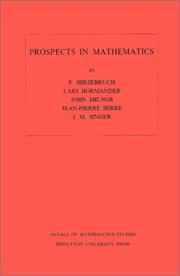
ISBN: 0691080941 9780691080949 1400881692 Year: 1971 Volume: 70 Publisher: Princeton
Abstract | Keywords | Export | Availability | Bookmark
 Loading...
Loading...Choose an application
- Reference Manager
- EndNote
- RefWorks (Direct export to RefWorks)
Five papers by distinguished American and European mathematicians describe some current trends in mathematics in the perspective of the recent past and in terms of expectations for the future. Among the subjects discussed are algebraic groups, quadratic forms, topological aspects of global analysis, variants of the index theorem, and partial differential equations.
Mathematics --- Mathématiques --- Congresses --- Congrès --- 51 --- -Math --- Science --- Congresses. --- -Mathematics --- 51 Mathematics --- -51 Mathematics --- Math --- Mathématiques --- Congrès --- A priori estimate. --- Addition. --- Additive group. --- Affine space. --- Algebraic geometry. --- Algebraic group. --- Atiyah–Singer index theorem. --- Bernoulli number. --- Boundary value problem. --- Bounded operator. --- C*-algebra. --- Canonical transformation. --- Cauchy problem. --- Characteristic class. --- Clifford algebra. --- Coefficient. --- Cohomology. --- Commutative property. --- Commutative ring. --- Complex manifold. --- Complex number. --- Complex vector bundle. --- Dedekind sum. --- Degenerate bilinear form. --- Diagram (category theory). --- Diffeomorphism. --- Differentiable manifold. --- Differential operator. --- Dimension (vector space). --- Ellipse. --- Elliptic operator. --- Equation. --- Euler characteristic. --- Euler number. --- Existence theorem. --- Exotic sphere. --- Finite difference. --- Finite group. --- Fourier integral operator. --- Fourier transform. --- Fourier. --- Fredholm operator. --- Hardy space. --- Hilbert space. --- Holomorphic vector bundle. --- Homogeneous coordinates. --- Homomorphism. --- Homotopy. --- Hyperbolic partial differential equation. --- Identity component. --- Integer. --- Integral transform. --- Isomorphism class. --- John Milnor. --- K-theory. --- Lebesgue measure. --- Line bundle. --- Local ring. --- Mathematics. --- Maximal ideal. --- Modular form. --- Module (mathematics). --- Monoid. --- Normal bundle. --- Number theory. --- Open set. --- Parametrix. --- Parity (mathematics). --- Partial differential equation. --- Piecewise linear manifold. --- Poisson bracket. --- Polynomial ring. --- Polynomial. --- Prime number. --- Principal part. --- Projective space. --- Pseudo-differential operator. --- Quadratic form. --- Rational variety. --- Real number. --- Reciprocity law. --- Resolution of singularities. --- Riemann–Roch theorem. --- Shift operator. --- Simply connected space. --- Special case. --- Square-integrable function. --- Subalgebra. --- Submanifold. --- Support (mathematics). --- Surjective function. --- Symmetric bilinear form. --- Symplectic vector space. --- Tangent space. --- Theorem. --- Topology. --- Variable (mathematics). --- Vector bundle. --- Vector space. --- Winding number. --- Mathematics - Congresses
Book
ISBN: 0691080917 1400881781 9780691080918 Year: 1971 Volume: 68 Publisher: Princeton, N.J.
Abstract | Keywords | Export | Availability | Bookmark
 Loading...
Loading...Choose an application
- Reference Manager
- EndNote
- RefWorks (Direct export to RefWorks)
Part exposition and part presentation of new results, this monograph deals with that area of mathematics which has both combinatorial group theory and mathematical logic in common. Its main topics are the word problem for groups, the conjugacy problem for groups, and the isomorphism problem for groups. The presentation depends on previous results of J. L. Britton, which, with other factual background, are treated in detail.
Group theory --- 510.6 --- Mathematical logic --- 510.6 Mathematical logic --- Group theory. --- Logic, Symbolic and mathematical. --- Groupes, Théorie des --- Groups, Theory of --- Substitutions (Mathematics) --- Algebra --- Algebra of logic --- Logic, Universal --- Symbolic and mathematical logic --- Symbolic logic --- Mathematics --- Algebra, Abstract --- Metamathematics --- Set theory --- Syllogism --- Abelian group. --- Betti number. --- Characteristic function (probability theory). --- Characterization (mathematics). --- Combinatorial group theory. --- Conjecture. --- Conjugacy class. --- Conjugacy problem. --- Contradiction. --- Corollary. --- Cyclic permutation. --- Decision problem. --- Diffeomorphism. --- Direct product. --- Direct proof. --- Effective method. --- Elementary class. --- Embedding. --- Enumeration. --- Epimorphism. --- Equation. --- Equivalence relation. --- Exact sequence. --- Existential quantification. --- Finite group. --- Finite set. --- Finitely generated group. --- Finitely presented. --- Free group. --- Free product. --- Fundamental group. --- Fundamental theorem. --- Group (mathematics). --- Gödel numbering. --- Homomorphism. --- Homotopy. --- Inner automorphism. --- Markov property. --- Mathematical logic. --- Mathematical proof. --- Mathematics. --- Monograph. --- Natural number. --- Nilpotent group. --- Normal subgroup. --- Notation. --- Permutation. --- Polycyclic group. --- Presentation of a group. --- Quotient group. --- Recursive set. --- Requirement. --- Residually finite group. --- Semigroup. --- Simple set. --- Simplicial complex. --- Solvable group. --- Statistical hypothesis testing. --- Subgroup. --- Theorem. --- Theory. --- Topology. --- Transitive relation. --- Triviality (mathematics). --- Truth table. --- Turing degree. --- Turing machine. --- Without loss of generality. --- Word problem (mathematics). --- Groupes, Théorie des --- Décidabilité (logique mathématique)
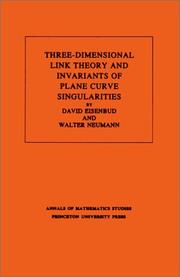
ISBN: 0691083819 0691083800 1400881927 9780691083810 9780691083803 Year: 1985 Volume: 110 Publisher: Princeton Princeton University Press
Abstract | Keywords | Export | Availability | Bookmark
 Loading...
Loading...Choose an application
- Reference Manager
- EndNote
- RefWorks (Direct export to RefWorks)
This book gives a new foundation for the theory of links in 3-space modeled on the modern developmentby Jaco, Shalen, Johannson, Thurston et al. of the theory of 3-manifolds. The basic construction is a method of obtaining any link by "splicing" links of the simplest kinds, namely those whose exteriors are Seifert fibered or hyperbolic. This approach to link theory is particularly attractive since most invariants of links are additive under splicing.Specially distinguished from this viewpoint is the class of links, none of whose splice components is hyperbolic. It includes all links constructed by cabling and connected sums, in particular all links of singularities of complex plane curves. One of the main contributions of this monograph is the calculation of invariants of these classes of links, such as the Alexander polynomials, monodromy, and Seifert forms.
Algebraic geometry --- Differential geometry. Global analysis --- Link theory. --- Curves, Plane. --- SINGULARITIES (Mathematics) --- Curves, Plane --- Invariants --- Link theory --- Singularities (Mathematics) --- Geometry, Algebraic --- Low-dimensional topology --- Piecewise linear topology --- Higher plane curves --- Plane curves --- Invariants. --- 3-sphere. --- Alexander Grothendieck. --- Alexander polynomial. --- Algebraic curve. --- Algebraic equation. --- Algebraic geometry. --- Algebraic surface. --- Algorithm. --- Ambient space. --- Analytic function. --- Approximation. --- Big O notation. --- Call graph. --- Cartesian coordinate system. --- Characteristic polynomial. --- Closed-form expression. --- Cohomology. --- Computation. --- Conjecture. --- Connected sum. --- Contradiction. --- Coprime integers. --- Corollary. --- Curve. --- Cyclic group. --- Determinant. --- Diagram (category theory). --- Diffeomorphism. --- Dimension. --- Disjoint union. --- Eigenvalues and eigenvectors. --- Equation. --- Equivalence class. --- Euler number. --- Existential quantification. --- Exterior (topology). --- Fiber bundle. --- Fibration. --- Foliation. --- Fundamental group. --- Geometry. --- Graph (discrete mathematics). --- Ground field. --- Homeomorphism. --- Homology sphere. --- Identity matrix. --- Integer matrix. --- Intersection form (4-manifold). --- Isolated point. --- Isolated singularity. --- Jordan normal form. --- Knot theory. --- Mathematical induction. --- Monodromy matrix. --- Monodromy. --- N-sphere. --- Natural transformation. --- Newton polygon. --- Newton's method. --- Normal (geometry). --- Notation. --- Pairwise. --- Parametrization. --- Plane curve. --- Polynomial. --- Power series. --- Projective plane. --- Puiseux series. --- Quantity. --- Rational function. --- Resolution of singularities. --- Riemann sphere. --- Riemann surface. --- Root of unity. --- Scientific notation. --- Seifert surface. --- Set (mathematics). --- Sign (mathematics). --- Solid torus. --- Special case. --- Stereographic projection. --- Submanifold. --- Summation. --- Theorem. --- Three-dimensional space (mathematics). --- Topology. --- Torus knot. --- Torus. --- Tubular neighborhood. --- Unit circle. --- Unit vector. --- Unknot. --- Variable (mathematics).
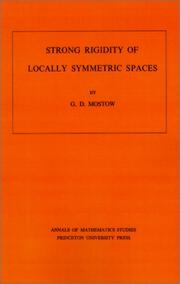
ISBN: 0691081360 1400881838 9780691081366 Year: 1973 Volume: 78 Publisher: Princeton (N.J.): Princeton university press,
Abstract | Keywords | Export | Availability | Bookmark
 Loading...
Loading...Choose an application
- Reference Manager
- EndNote
- RefWorks (Direct export to RefWorks)
Locally symmetric spaces are generalizations of spaces of constant curvature. In this book the author presents the proof of a remarkable phenomenon, which he calls "strong rigidity": this is a stronger form of the deformation rigidity that has been investigated by Selberg, Calabi-Vesentini, Weil, Borel, and Raghunathan.The proof combines the theory of semi-simple Lie groups, discrete subgroups, the geometry of E. Cartan's symmetric Riemannian spaces, elements of ergodic theory, and the fundamental theorem of projective geometry as applied to Tit's geometries. In his proof the author introduces two new notions having independent interest: one is "pseudo-isometries"; the other is a notion of a quasi-conformal mapping over the division algebra K (K equals real, complex, quaternion, or Cayley numbers). The author attempts to make the account accessible to readers with diverse backgrounds, and the book contains capsule descriptions of the various theories that enter the proof.
Differential geometry. Global analysis --- Riemannian manifolds --- Symmetric spaces --- Rigidity (Geometry) --- 512 --- Lie groups --- Geometric rigidity --- Rigidity theorem --- Discrete geometry --- Spaces, Symmetric --- Geometry, Differential --- Manifolds, Riemannian --- Riemannian space --- Space, Riemannian --- Manifolds (Mathematics) --- Groups, Lie --- Lie algebras --- Topological groups --- Algebra --- Lie groups. --- Riemannian manifolds. --- Symmetric spaces. --- Rigidity (Geometry). --- 512 Algebra --- Addition. --- Adjoint representation. --- Affine space. --- Approximation. --- Automorphism. --- Axiom. --- Big O notation. --- Boundary value problem. --- Cohomology. --- Compact Riemann surface. --- Compact space. --- Conjecture. --- Constant curvature. --- Corollary. --- Counterexample. --- Covering group. --- Covering space. --- Curvature. --- Diameter. --- Diffeomorphism. --- Differentiable function. --- Dimension. --- Direct product. --- Division algebra. --- Ergodicity. --- Erlangen program. --- Existence theorem. --- Exponential function. --- Finitely generated group. --- Fundamental domain. --- Fundamental group. --- Geometry. --- Half-space (geometry). --- Hausdorff distance. --- Hermitian matrix. --- Homeomorphism. --- Homomorphism. --- Hyperplane. --- Identity matrix. --- Inner automorphism. --- Isometry group. --- Jordan algebra. --- Matrix multiplication. --- Metric space. --- Morphism. --- Möbius transformation. --- Normal subgroup. --- Normalizing constant. --- Partially ordered set. --- Permutation. --- Projective space. --- Riemann surface. --- Riemannian geometry. --- Sectional curvature. --- Self-adjoint. --- Set function. --- Smoothness. --- Stereographic projection. --- Subgroup. --- Subset. --- Summation. --- Symmetric space. --- Tangent space. --- Tangent vector. --- Theorem. --- Topology. --- Tubular neighborhood. --- Two-dimensional space. --- Unit sphere. --- Vector group. --- Weyl group. --- Riemann, Variétés de --- Lie, Groupes de --- Geometrie differentielle globale --- Varietes riemanniennes
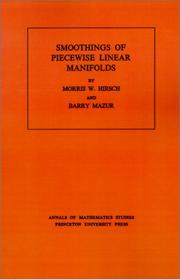
ISBN: 069108145X 1400881684 Year: 1974 Volume: no. 80 Publisher: Princeton (N.J.): Princeton university press
Abstract | Keywords | Export | Availability | Bookmark
 Loading...
Loading...Choose an application
- Reference Manager
- EndNote
- RefWorks (Direct export to RefWorks)
The intention of the authors is to examine the relationship between piecewise linear structure and differential structure: a relationship, they assert, that can be understood as a homotopy obstruction theory, and, hence, can be studied by using the traditional techniques of algebraic topology.Thus the book attacks the problem of existence and classification (up to isotopy) of differential structures compatible with a given combinatorial structure on a manifold. The problem is completely "solved" in the sense that it is reduced to standard problems of algebraic topology.The first part of the book is purely geometrical; it proves that every smoothing of the product of a manifold M and an interval is derived from an essentially unique smoothing of M. In the second part this result is used to translate the classification of smoothings into the problem of putting a linear structure on the tangent microbundle of M. This in turn is converted to the homotopy problem of classifying maps from M into a certain space PL/O. The set of equivalence classes of smoothings on M is given a natural abelian group structure.
Algebraic topology --- Piecewise linear topology --- Manifolds (Mathematics) --- Topologie linéaire par morceaux --- Variétés (Mathématiques) --- 515.16 --- PL topology --- Topology --- Geometry, Differential --- Topology of manifolds --- Piecewise linear topology. --- Manifolds (Mathematics). --- 515.16 Topology of manifolds --- Topologie linéaire par morceaux --- Variétés (Mathématiques) --- Affine transformation. --- Approximation. --- Associative property. --- Bijection. --- Bundle map. --- Classification theorem. --- Codimension. --- Coefficient. --- Cohomology. --- Commutative property. --- Computation. --- Convex cone. --- Convolution. --- Corollary. --- Counterexample. --- Diffeomorphism. --- Differentiable function. --- Differentiable manifold. --- Differential structure. --- Dimension. --- Direct proof. --- Division by zero. --- Embedding. --- Empty set. --- Equivalence class. --- Equivalence relation. --- Euclidean space. --- Existential quantification. --- Exponential map (Lie theory). --- Fiber bundle. --- Fibration. --- Functor. --- Grassmannian. --- H-space. --- Homeomorphism. --- Homotopy. --- Integral curve. --- Inverse problem. --- Isomorphism class. --- K0. --- Linearization. --- Manifold. --- Mathematical induction. --- Milnor conjecture. --- Natural transformation. --- Neighbourhood (mathematics). --- Normal bundle. --- Obstruction theory. --- Open set. --- Partition of unity. --- Piecewise linear. --- Polyhedron. --- Reflexive relation. --- Regular map (graph theory). --- Sheaf (mathematics). --- Smoothing. --- Smoothness. --- Special case. --- Submanifold. --- Tangent bundle. --- Tangent vector. --- Theorem. --- Topological manifold. --- Topological space. --- Topology. --- Transition function. --- Transitive relation. --- Vector bundle. --- Vector field. --- Variétés topologiques
| Listing 1 - 10 of 42 | << page >> |
Sort by
|

 Search
Search Feedback
Feedback About UniCat
About UniCat  Help
Help News
News